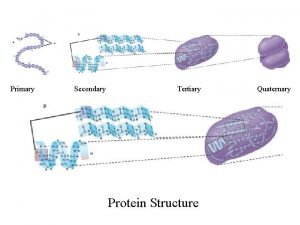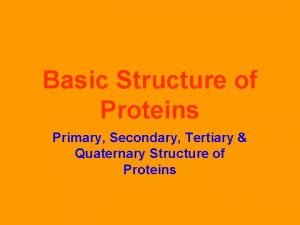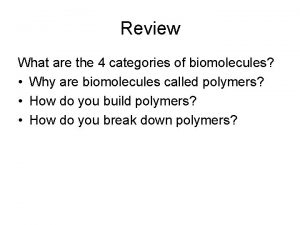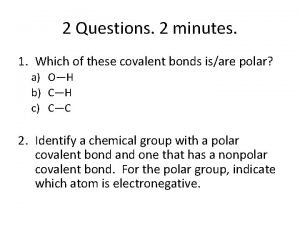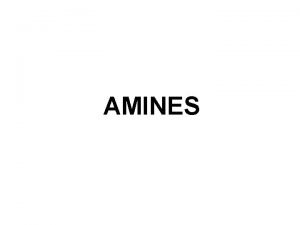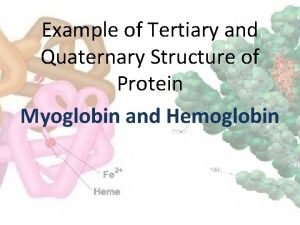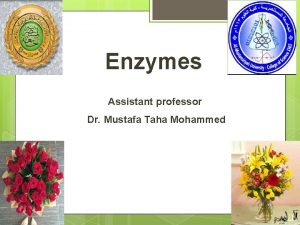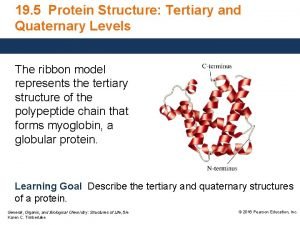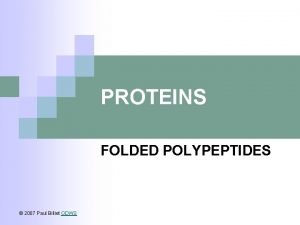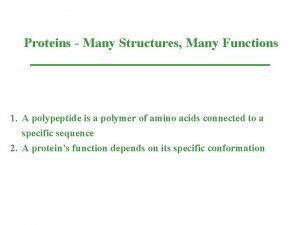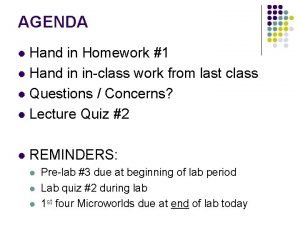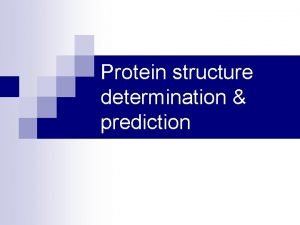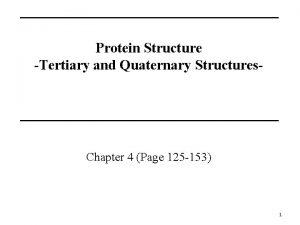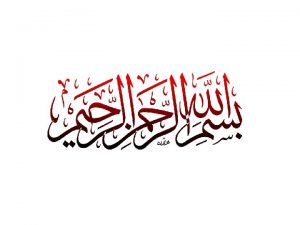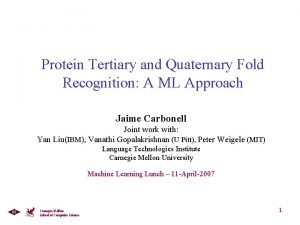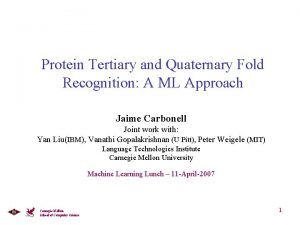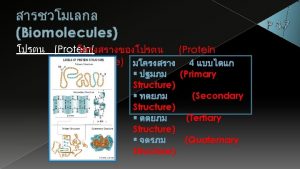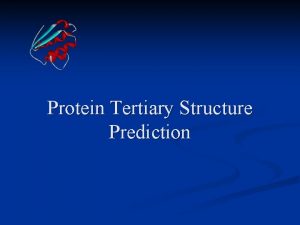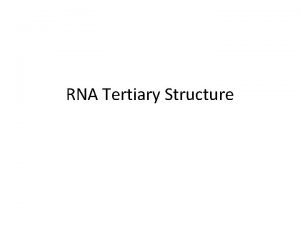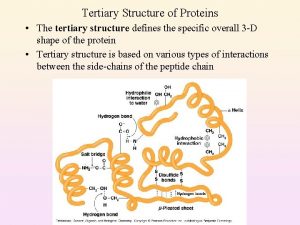Example of Tertiary and Quaternary Structure of Protein











![Bohr effect • ↑[H+] – protonation of N terminal in Hb • Create a Bohr effect • ↑[H+] – protonation of N terminal in Hb • Create a](https://slidetodoc.com/presentation_image_h/d02e4a82f44065503a4df69897dee593/image-12.jpg)


- Slides: 14

Example of Tertiary and Quaternary Structure of Protein Myoglobin and Hemoglobin

Myoglobin • Was the first protein the complete tertiary structure was determined by X-tray crystallography • Has 8 α-helical region and no βpleated • Hydrogen binding stabilize the αhelical region • Consist of a single polypeptide chain of 153 a. acid residue and includes prosthetic group- one heme group • Store oxygen as reserve against oxygen deprivation

• Example of quaternary structure of protein • Consist 4 polypeptide chain -4 subunit - tetramer • Each subunit consist one heme group (the same found in myoglobin) • The chain interact with each other through noncovalent interaction – electrostatic interaction, hydrogen bonds, and hydrophobic interaction • any changes in structure of proteinwill cause drastic changes to its property • this condition is called allostery Hemoglobin

Hemoglobin • An allosteric protein • Tetramer, 4 polypeptide chains (α 2β 2) 2α-chains and 2β-chains – nothing to do with αhelix and βsheet- its just a greek name • Bind O 2 in lungs and transport it to cells • Transport C 02 and H+ from tissue to lungs • The same heme group in mb and hb • Cyanide and carbon monoxide kill because they disrupt the physiologic function of hemoglobin • 2, 3 - biphosphoglycerate (BPG) promotes the efficient release of 02

Heme Group • Mb and Hb contain heme – a prosthetic group • Responsible to bind to 02 • Consist of heterocyclic organic ring (porphyrin) and iron atom (Fe 2+) • Oxidation of Fe 2 t to Fe 3+ destroy their biologic activity • Fe has 6 coordination sites that can form complexation bonds • Four are occupied by the N atoms • Free heme can bind CO 25, 000 times than 02 – how Mb and Hb overcome this problem?

• The perfect orientation for CO binding is when all 3 atoms (Fe, C and O) perpendicular to the plane of heme • Mb and Hb create hindered environment- do not allow O 2 to bind at the required orientation- less affinity • The fifth coordination is occupied by Histidine residue F 8 • The O 2 is bound at the 6 th coordination site of iron Structure of heme group in Mb and HB

heme group • The second histidine His E 7 – not bound to the heme, but acts a gate to open and closes as oxygen enter the hydrophobic pocket • E 7 inhibit O 2 to bind to perpendicularly to heme • The presence of His E 7 – will force CO to bind at the 120 angle – make it lose it affinity to heme

Oxygen saturation in Mb and Hb • One molecule of Mb- can bind one molecule 02 • HB (4 molecule)- can bind 4 02 • O 2 bind to HB thru positive cooperativity – when one O 2 is bound, it become easier for the next to bind • Dissociation of one O 2 from oxygenated Hb will make the dissociation of 02 from other subunits easier

Different form of HB • Hb is bound to 02 - oxyhemoglobin – relaxed (R state) • Without 02 – deoxyhb – tense (T) state • If Fe 2+ is oxidized to Fe 3+ - unable to bind 02 methemoglobin • C 0 and NO have higher affinity for heme FE 2+ than 02 - toxicity

Oxygen-saturation curve • Myoglobin is showing hyperbolic curve – easily saturated by increment of O 2 pressure • Hb-sigmoidal curve – under the same pressure where Mb already near to saturation, Hb is still ‘struggling’ to catch 02. • But, once one 02 bind to the molecule – more will bind to itcooperativity- increase in saturation • Same condition for dissociation of O 2 • Hb will release 02 easily in tissues compare to MB-thus make it a good 02 transporter

Bohr Effect • Hb also transport CO 2 and H+ from tissues to lungs • When H+ and C 02 bind to Hb- affect the affinity of Hb for oxygen – by altering the 3 D structure • The effect of H+ - Bohr Effect • Not occur in Mb
![Bohr effect H protonation of N terminal in Hb Create a Bohr effect • ↑[H+] – protonation of N terminal in Hb • Create a](https://slidetodoc.com/presentation_image_h/d02e4a82f44065503a4df69897dee593/image-12.jpg)
Bohr effect • ↑[H+] – protonation of N terminal in Hb • Create a salt bridge • Low affinity of Hb to O 2 • Metabolically active tissues need more 02 - they generate more C 02 and H+ which causes hemoglobin to release its 02 • C 02 produced in metabolism are in the form of H 2 CO 3→ HCO 3 - and H+ • HC 03 - is transported to lungs and combined with H+→ C 02 – exhaled • This process allow fine tuning Ph and level of C 02 and 02

2, 3 Biphosphoglycerate (BPG) • An intermediate compound found in glucose metabolism pathway • Bind to T state of Hb to stabilize Hb and make it less affinity towards 02 - will release 02 to cell • e: g: animal is quickly transported to mount side at altitude 4500 m where the P 02 is lower – delivery of 02 to tissue reduced • After few hours at high altitude[BPG] in blood increase- decrease affinity of Hb to 02 -delivery of O 2 to tissues is restored • The situation is reversed when the animal is returned to the sea level

2, 3 Biphosphoglycerate (BPG) • BPG also play role in supplying growing fetus with oxygen • Fetus must extract oxygen from its mother’s blood. Fetal Hb (Hb. F) must have higher affinity than the maternal Hb (Hb. A) for 02 • Hb. F has α 2γ 2 subunit • This s/u has lower affinity towards BPG - higher affinity to O 2 compare to Hb. A
 Secondary to tertiary structure
Secondary to tertiary structure Three peptide chains woven like a rope
Three peptide chains woven like a rope Nitrogen base
Nitrogen base Quaternary structure of protein
Quaternary structure of protein Tertiary amine
Tertiary amine Quaternary structure of myoglobin
Quaternary structure of myoglobin Holoenzyme
Holoenzyme Levels of care primary secondary tertiary quaternary
Levels of care primary secondary tertiary quaternary Primary secondary and tertiary protein structure
Primary secondary and tertiary protein structure Primary secondary and tertiary structure of protein
Primary secondary and tertiary structure of protein Protein tertiary structure bonds
Protein tertiary structure bonds Leucine polar or nonpolar
Leucine polar or nonpolar Protein structure
Protein structure Protein pump vs protein channel
Protein pump vs protein channel Protein-protein docking
Protein-protein docking
